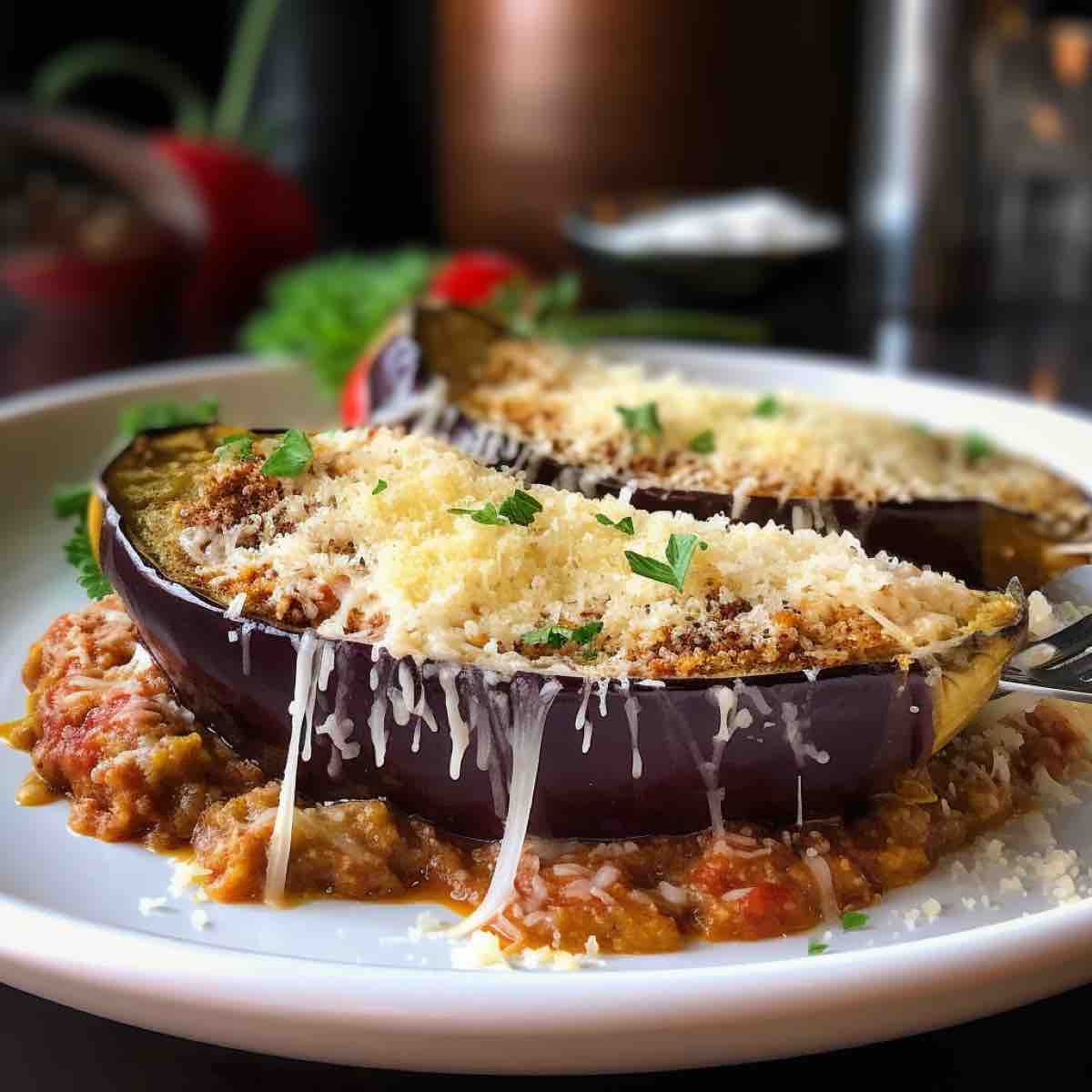Egg Substitute For Eggplant Parmesan

Egg Substitute For Eggplant Parmesan: A Guide To Vegan And Allergy-Friendly Options
Eggplant parmesan is a classic Italian dish that is beloved by many. However, the traditional recipe calls for eggs to help bind the breading to the eggplant slices.
This can be a problem for those who are allergic to eggs or who follow a vegan diet. Fortunately, several egg substitutes can be used in eggplant parmesan recipes just like in burgers
One popular substitute for eggs in eggplant parmesan is almond milk mixed with cornstarch. This creates a thick, creamy mixture that can be used to coat the eggplant slices before breading.
Another option is to use aquafaba, which is the liquid from a can of chickpeas. This can be whipped into a foam and used as a binding agent for the breading. Other substitutes include silken tofu, mashed avocado, or even applesauce.
Each of these options has its own unique flavor and texture, so it’s worth experimenting to find the one that works best for you.
Whether you’re looking for a vegan version of eggplant parmesan or simply want to avoid using eggs, plenty of substitutes are available. With a little creativity and experimentation, you can create a delicious and satisfying dish that is sure to please.
Why Use an Egg Substitute for Eggplant Parmesan?
Eggplant Parmesan is a delicious and hearty dish that is loved by many. However, it is traditionally made with eggs, which can be a problem for those who are allergic to eggs, vegan, or simply trying to reduce their consumption of animal products. In such cases, using an egg substitute is a great option.

Egg substitutes can be used in place of eggs in many recipes, including Eggplant Parmesan. They are made from a variety of ingredients, such as tofu, chickpea flour, flaxseeds, and applesauce.
These substitutes provide a similar texture and binding power as eggs, making them a great alternative and also some are used in making egg-free latkes.
By using an egg substitute, you can also reduce the amount of cholesterol and calories in your dish. Eggs are high in cholesterol, and using an egg substitute can help reduce your intake. Additionally, egg substitutes are often lower in calories than eggs, which can be helpful for those watching their weight.
Another benefit of using an egg substitute is that it eliminates the need for frying the eggplant slices. In traditional Eggplant Parmesan recipes, the eggplant slices are often coated in breadcrumbs and fried in oil. This can be time-consuming and messy, and it adds unnecessary calories to the dish. By using an egg substitute, you can skip the frying step and simply bake or roast the eggplant slices.
Finally, using an egg substitute can also help you make a larger casserole or more servings of Eggplant Parmesan. Eggs can be limiting in terms of how much you can use in a recipe, but with an egg substitute, you can make a larger casserole or more servings without worrying about running out of eggs.
Overall, using an egg substitute for Eggplant Parmesan is a great option for those who are allergic to eggs, vegan, or simply looking to reduce their consumption of animal products. It can also help reduce cholesterol and calories, eliminate the need for frying, and allow for more servings.

Types of Egg Substitutes for Eggplant Parmesan
Eggplant parmesan is a classic Italian dish that is usually made by dipping eggplant slices in egg and breadcrumbs before frying and layering them with tomato sauce and cheese. However, for those who are allergic to eggs or prefer a vegan diet, egg substitutes can be used instead of eggs. In this section, we will discuss the different types of egg substitutes that can be used for eggplant parmesan.
Vegan Egg Substitutes
For those following a vegan diet, there are several options for egg substitutes that can be used in eggplant parmesan. Here are some of the most popular vegan egg substitutes:
- Flaxseed and water: mix 1 tablespoon of ground flaxseed with 3 tablespoons of water and let it sit for a few minutes until it thickens.
- Silken tofu: blend 1/4 cup of silken tofu until smooth.
- Applesauce: use 1/4 cup of unsweetened applesauce instead of one egg.
- Mashed bananas: use 1/4 cup of mashed bananas instead of one egg.
These vegan egg substitutes work well in eggplant parmesan and provide the necessary binding and moisture that eggs usually provide.
Non-Vegan Egg Substitutes
For those who are not following a vegan diet but are allergic to eggs, there are also non-vegan egg substitutes that can be used in eggplant parmesan. Here are some of the most popular non-vegan egg substitutes:
- Milk and flour mixture: mix 1/4 cup of milk with 1 tablespoon of flour to create a paste.
- Yogurt: use 1/4 cup of plain yogurt instead of one egg.
- Buttermilk: use 1/4 cup of buttermilk instead of one egg.
These non-vegan egg substitutes work well in eggplant parmesan and provide the necessary binding and moisture that eggs usually provide.
When making eggplant parmesan with egg substitutes, it is important to note that the texture and taste may be slightly different from the traditional recipe that uses eggs. However, the dish will still be delicious and satisfying.
In conclusion, egg substitutes are a great option for those who are allergic to eggs or prefer a vegan diet. By using the egg substitutes mentioned above, you can create a delicious eggplant parmesan that is both healthy and flavorful.
How to Use Egg Substitutes for Eggplant Parmesan
Eggplant Parmesan is a classic Italian dish that is both delicious and satisfying. However, traditional recipes call for eggs to help bind the breading to the eggplant slices. If you’re looking for a way to make this dish without using eggs, there are several egg substitutes that you can use instead. Here’s how to use egg substitutes for Eggplant Parmesan.

Baked Eggplant Parmesan with Egg Substitute
To make baked Eggplant Parmesan with an egg substitute, start by preheating your oven to 375°F. Then, slice your eggplant into rounds and season them with salt and pepper. In a shallow dish, mix together all-purpose flour, breadcrumbs, and your choice of egg substitute (such as almond milk or cornstarch). Dip each eggplant slice into the mixture, making sure to coat both sides. Place the breaded eggplant slices onto a parchment-lined baking sheet and bake for 20-25 minutes, or until crispy and golden brown.
Once the eggplant is cooked, assemble the dish by layering marinara sauce, shredded mozzarella cheese, and grated Parmesan cheese on top of the eggplant slices. Repeat the layers until you’ve used up all of your ingredients. Bake the casserole for an additional 15-20 minutes, or until the cheese is melted and bubbly. Garnish with fresh basil leaves before serving.
Fried Eggplant Parmesan with Egg Substitute
If you prefer a crispy, fried version of Eggplant Parmesan, you can use an egg substitute to help bind the breading to the eggplant slices. Start by slicing your eggplant into rounds and seasoning them with salt and pepper. In a shallow dish, mix together all-purpose flour, breadcrumbs, and your choice of egg substitute (such as almond milk or cornstarch). Dip each eggplant slice into the mixture, making sure to coat both sides.
Heat a large skillet over medium-high heat and add enough oil to cover the bottom of the pan. Once the oil is hot, add the breaded eggplant slices and cook for 2-3 minutes on each side, or until crispy and golden brown. Remove the eggplant slices from the skillet and place them on a paper towel-lined plate to drain any excess oil.
Once the eggplant is cooked, assemble the dish by layering marinara sauce, shredded mozzarella cheese, and grated Parmesan cheese on top of the eggplant slices. Repeat the layers until you’ve used up all of your ingredients. Bake the casserole in a preheated oven at 375°F for 15-20 minutes, or until the cheese is melted and bubbly.
In conclusion, using egg substitutes in Eggplant Parmesan is a great way to make this classic dish healthier and more accessible to those with dietary restrictions. Whether you choose to bake or fry your eggplant slices, there are plenty of egg substitutes available that will help bind the breading to the eggplant and create a crispy, delicious coating.
Eggplant Parmesan Recipe
Eggplant parmesan is a classic Italian dish that is loved by many. It is a vegetarian dish that is often served as a main course. The traditional recipe calls for eggs, but for those who are allergic to eggs or follow a vegan diet, there are several egg substitutes that can be used.
Here is a simple recipe for eggplant parmesan that uses an egg substitute:
Ingredients
- 1 large eggplant
- 1 cup almond milk
- 1 tsp corn starch
- 1 cup grated parmesan cheese
- 1.5 cups panko bread crumbs
- 2 tsp dried oregano
- 1 cup red sauce
- ⅓ cup oil
- ¼ cup for shallow frying + for greasing
- 1 tsp salt
- 1 tsp black pepper powder
- 2 cups cooked spaghetti
Instructions
- Preheat the oven to 350 degrees F.
- Cut the eggplant into 1/2 inch slices and sprinkle with salt. Let it sit for 30 minutes to remove excess moisture.
- In a shallow dish, whisk together almond milk and corn starch to make an egg substitute.
- In another shallow dish, mix together panko bread crumbs, dried oregano, salt, and black pepper powder.
- Dip the eggplant slices into the egg substitute mixture, then coat them in the bread crumb mixture.
- Heat oil in a pan and shallow fry the eggplant slices until they are golden brown.
- Grease a baking dish and spread a layer of red sauce on the bottom.
- Layer the fried eggplant slices on top of the sauce, then sprinkle with grated parmesan cheese.
- Repeat the layers until all the eggplant slices are used up.
- Top with more red sauce and grated parmesan cheese.
- Bake in the oven for 25-30 minutes until the cheese is melted and bubbly.
- Serve hot with cooked spaghetti.
In conclusion, eggplant parmesan can be made without eggs by using almond milk and corn starch as an egg substitute. This recipe is simple and delicious, and can be enjoyed by everyone regardless of dietary restrictions.
Why do you soak eggplant in water before cooking?
When it comes to cooking eggplant, soaking it in water before cooking is a common practice. But why is it necessary? Here are a few reasons why soaking eggplant in water is recommended:
Reduces bitterness
Eggplants can be quite bitter, especially if they are not fresh or have been stored for too long. By soaking eggplant in water, you can reduce its bitterness. The water helps to draw out some of the bitter compounds from the eggplant, making it more palatable.
Removes excess moisture
Eggplants are made up of about 80-90% water, which can make them soggy and unappetizing if not cooked properly. By soaking eggplant in water before cooking, you can remove some of the excess moisture, which will help it to cook more evenly and become crispy on the outside.
Reduces oil absorption
Eggplant has a tendency to absorb a lot of oil when it is cooked, which can make it greasy and heavy. Soaking eggplant in water before cooking can help to reduce its oil absorption. The water helps to break down the eggplant’s cell walls, which makes it less likely to absorb oil during cooking.
To soak eggplant in water, simply slice it into the desired shape and size, then place it in a bowl of cold water. You can add salt to the water if you like, as this can help to further reduce bitterness and oil absorption. Let the eggplant soak for at least 30 minutes, or up to an hour, then drain and pat dry before cooking.
Overall, soaking eggplant in water before cooking is a simple and effective way to improve its texture and flavor. By following this step, you can ensure that your eggplant parmesan turns out perfectly every time.
Conclusion
In conclusion, there are many egg substitutes that can be used in eggplant parmesan recipes, making it a versatile and delicious dish for everyone to enjoy. Whether you are vegan, allergic to eggs, or simply looking for a healthier alternative, there are plenty of options available.
When making eggplant parmesan without eggs, it is important to choose a suitable replacement that will still provide the desired texture and flavor. Some of the best egg substitutes include almond milk, plant-based milk, and aquafaba, which is the liquid from a can of chickpeas. These ingredients can be used in conjunction with breadcrumbs and other seasonings to create a delicious and crispy coating for the eggplant.
Another option to consider is using a different vegetable altogether. Summer squash, zucchini, and portobello mushrooms can all be used as substitutes for eggplant in eggplant parmesan recipes. These vegetables provide a similar texture and flavor, and can be seasoned and cooked in the same way as eggplant.
Overall, eggplant parmesan is a delicious and versatile dish that can be enjoyed by everyone, regardless of dietary restrictions or preferences. By using egg substitutes or alternative vegetables, it is possible to create a delicious and healthy version of this classic Italian dish.
